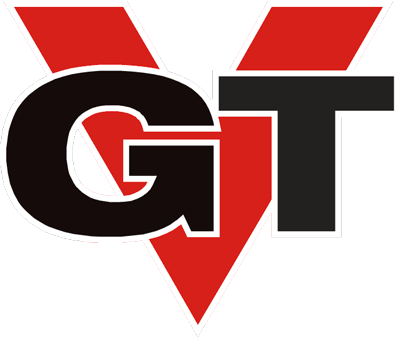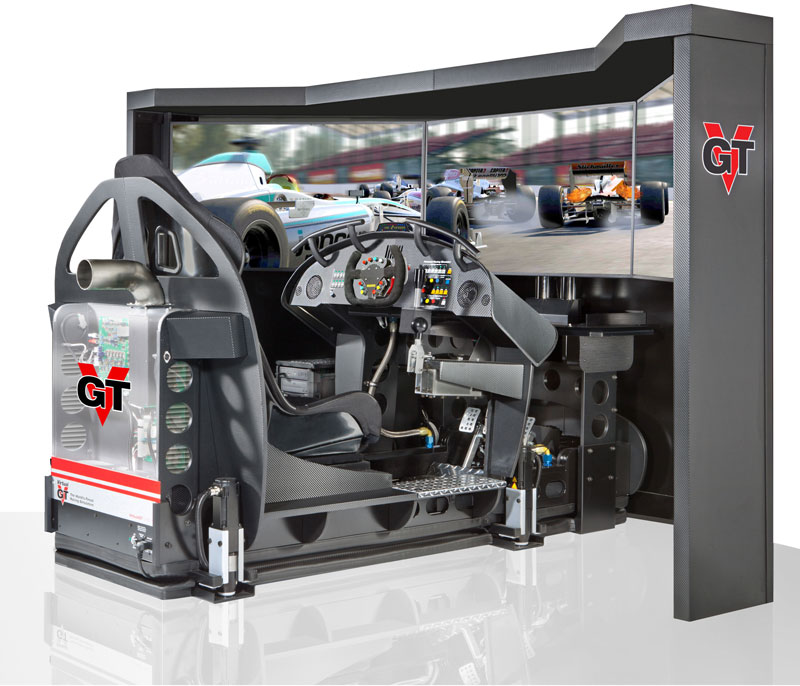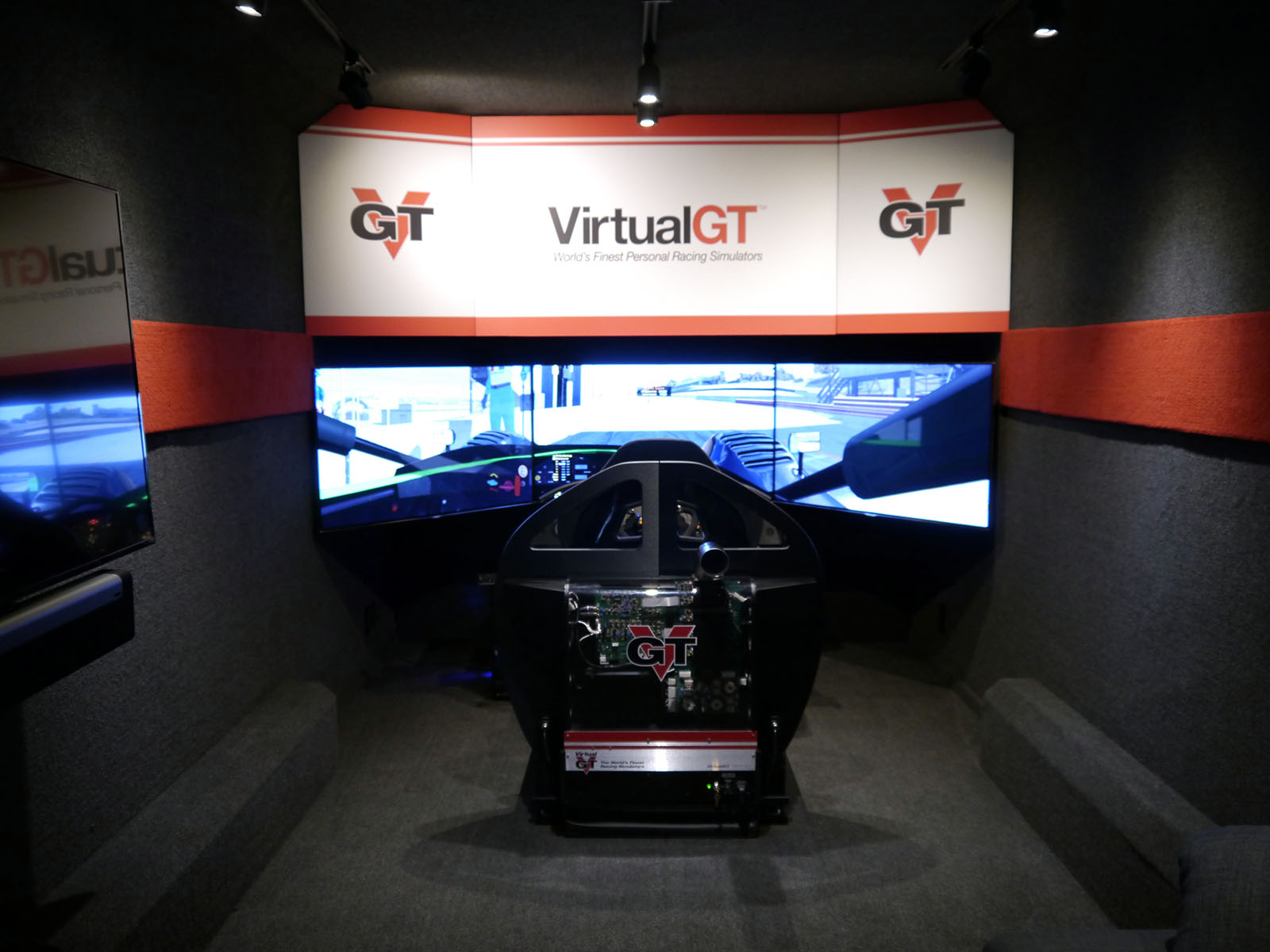The VirtualGT Story
Scroll down to understand the unique design of the VirtualGT racing simulator as well as the many performance advantages offered as a consequence of that design.
2022
VGT PRO CARBON
19 years after its introduction, VirtualGT remains the state-of-the-art in racing simulation.
What makes VGT so special?
- A unique cockpit design
- Custom electronics that power an integrated audio and vibration system
- Advanced motion that moves the entire cockpit
- Professional controls (steering, pedals and shifters)
- Fully enclosed triple-screen display system
- High performance racing PC built, configured and maintained by VirtualGT
- World-class support
2003
THE FIRST VGT
Introduced in 2003, VGT was based on PlayStation 2 and came equipped with a 24″ CRT television display.
As primitive as that first VGT was, looking back on it now, it blew people’s minds in 2003! The fundamental design is STILL the basis for the current state-of-the-art VirtualGT racing simulator.
Many improvements and upgrades have been made over the years, all of which can be retrofitted onto any of the over 550 VirtualGT simulators delivered since 2003.
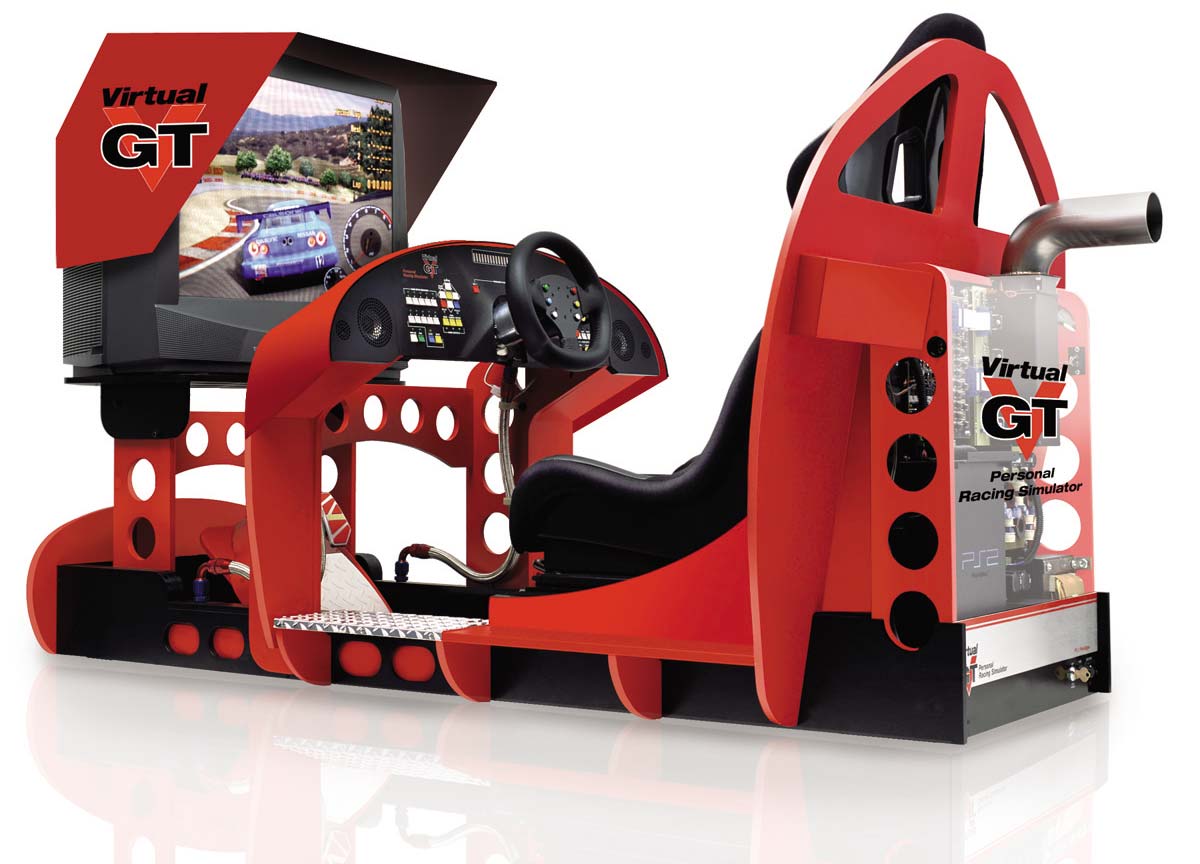
LONG BEACH GRAND PRIX – April 2003
It all started with the launch of VirtualGT racing simulators at the Long Beach Grand Prix in 2003.
In the photo below, two pro driving instructors from Skip Barber hung out in our VGT room every day after the Expo Hall closed. They always gathered a crowd to watch their thrilling bumper-to-bumper races on the Laguna Seca circuit where they instructed. Onlookers cheered and laughed as drivers traded places and paint during their highly competitive races.
Bob Bondurant spent 45 minutes in the seat and was amazed by the experience.
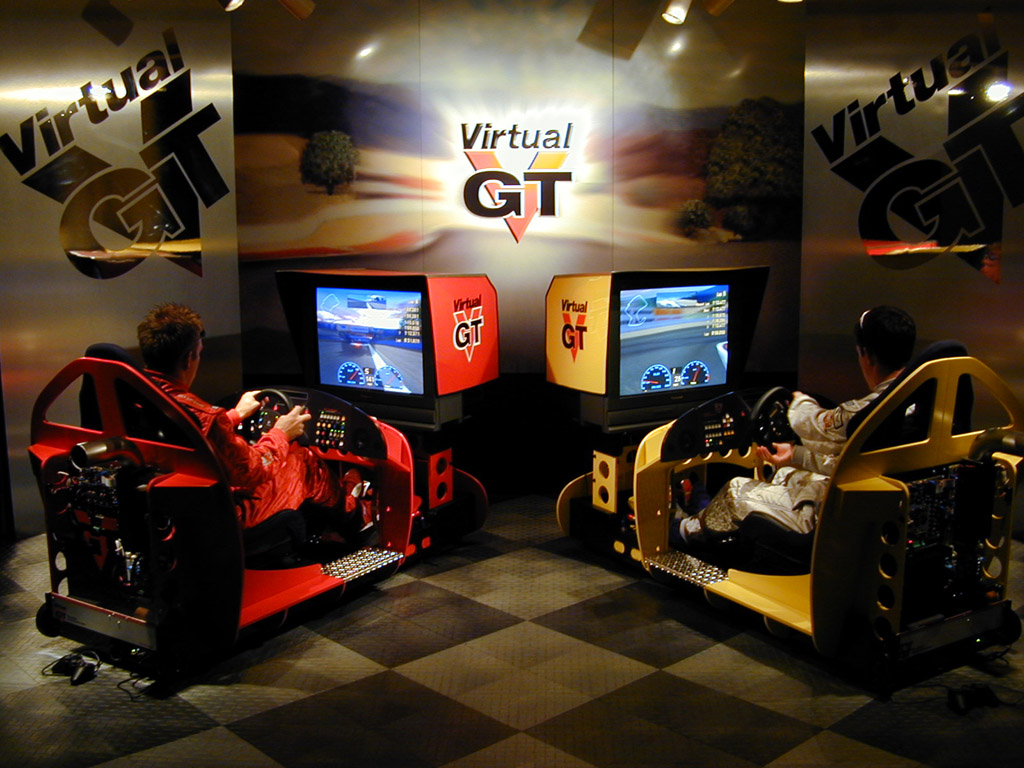
Why is VirtualGT Better?
Let’s look at the most important simulator design criteria and learn how VGT incorporates all of these at the highest level.
RACING SIMULATOR DESIGN
A quick review of racing simulator websites shows a common design thread. Most are a tubular steel frameworks with various components bolted onto that frame. The simplest of these provide a racing seat with platform to mount the steering wheel and pedals.
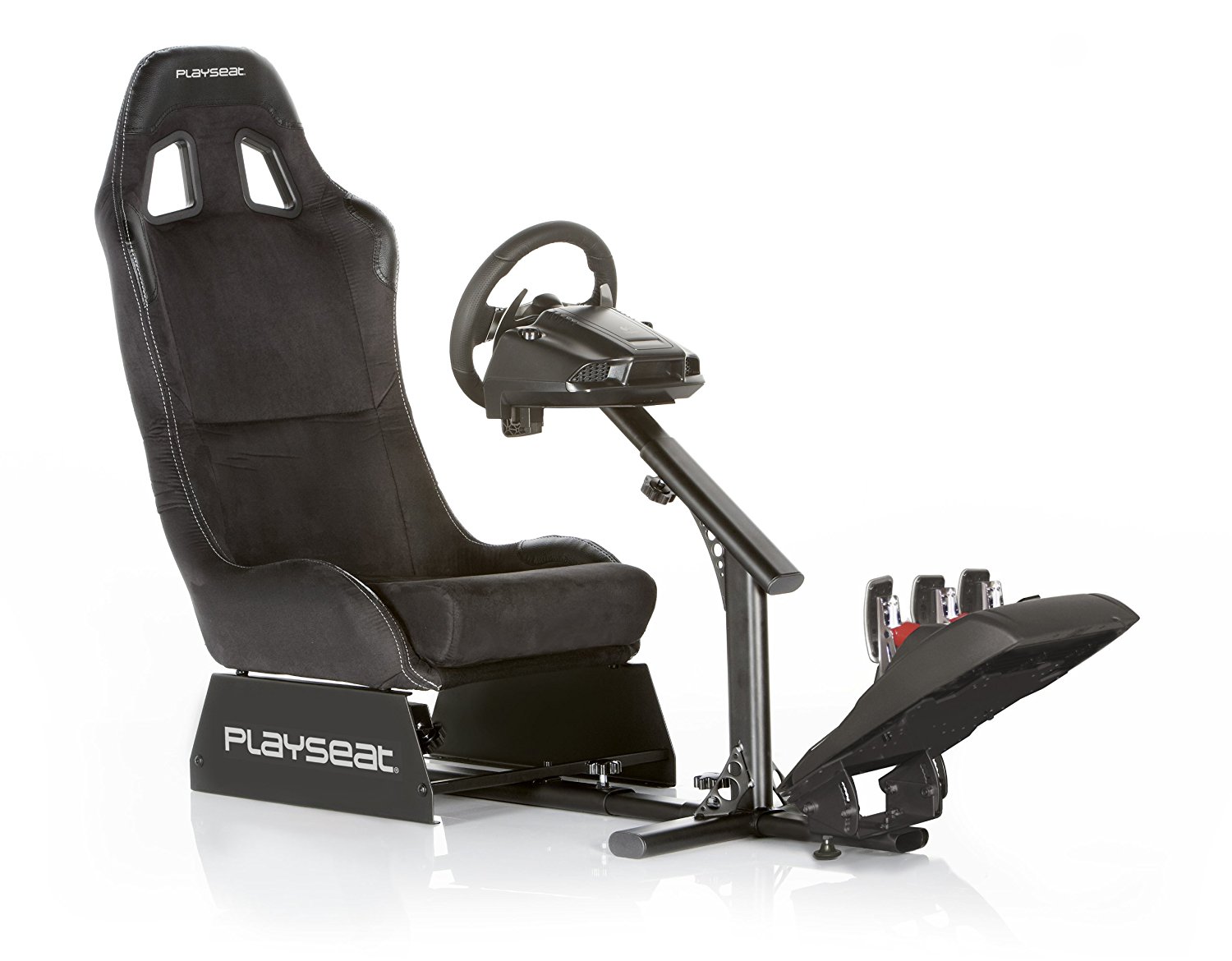
More deluxe models offer built-in display mounts and shifter mounts. But common among this design is the “erector set” look with very little to convey the feeling of being in a race car cockpit.
Most of these frames are relatively unstable, especially the inexpensive models like the Playseat.
Here is a comprehensive list of racing simulators like this, ordered by market position.
- CXC Simulations
- Vesaro
- SimXperience
- VRX
- Playseat and a host of other unnamed “race rigs” using similar construction.
This approach stems from a lack of understanding of how simulation really works. It actually has very little to do with a real race car but rather is a collection of carefully designed, scaled and balanced multimedia effects, working together to create an authentic illusion of driving a race car at speed.
A movie theater is a good example of how an illusion is best presented. First, you are removed from your existing reality. Walk into any movie theater and what do you see and hear? Very little! The interior surfaces absorb most of the light and sound. Then, for the next 2 hours, your existing reality is replaced with what you see, hear and feel, especially if they have D-BOX theater seating or a massive subwoofer system.
In short, the best racing simulator design should be based on multimedia theater terchnology, not race car technology.
SIMULATOR STRUCTURE
In the early days of racing simulators (circa 2000), a number of companies produced wood-based simulators. Only two remain today… Hyperstimulator and VirtualGT.
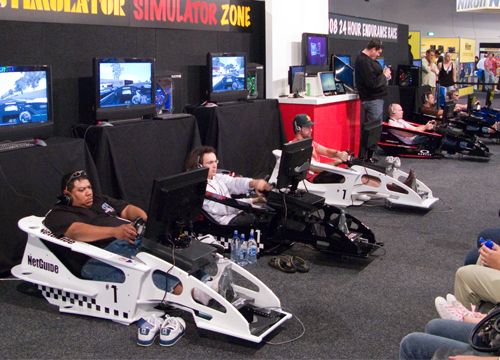
Hyperstimulators
However, the only similarity between a Hyperstimulator and a VirtualGT is wood. Similar in design concept to the tubular frame racing simulators mentioned above, Hyperstimulator offers no multimedia effects, sits on the floor, is hard to get into and out of, and looks like an open wheel racing cockpit.
VirtualGT is the only simulator in the world whose design intent is focused on delivering the best illusion of driving a race car.
Whereas many other simulator companies provide some or all of the various effects found in a fully-loaded VirtualGT, none offer a complete ultra high-fidelity racing experience as provided by VirtualGT.
HIGH-FIDELITY SIMULATION
What is high-fidelity simulation? It’s simulation that’s incredibly believable because everything you expect to see, hear and feel in a real race car is represented across the entire spectrum in a scaled and balanced way so that nothing stands out or is exaggerated.
That’s importantr because any effect that is exaggerated will eventually degrade the illusion. The idea is to fool your subconscious mind which is totally objective and constantly struggling to compare input data against experience.
On the other hand, your conscious mind is a willing participant in the simulation and so is eager to overlook any flaws. As a low-fidelity simulation progresses, the subconscious mind will eventually override any effort to consciously ignore problems and the illusion is degraded or lost entirely.
A good example of an exaggerated effect is how motion is often implemented in a racing simulator. Many simulators follow the line of thought that “if a little is good, more is better”. This is completely wrongheaded as motion is already a stretch for a racing simulator since it is NOT possible to reproduce the full motion of a race car.
The best simulated motion we can hope for are subtle motion cues… the transient onset effects of the motion. To exaggerate these transients only calls your attention to the fact that most of the motion is missing such as sustained G forces under braking or heavy cornering, or high acceleration. None of these forces can be accurately represented in an affordable simulator.
FULL-BODY EXPERIENCE
VirtualGT delivers what we call a Full Body Experience by combining four systems: (1) motion; (2) vibration; (3) subwoofer speaker; and (4) satellite speakers. These reproduce the entire range of physical human experience from DC to 20 kHz in four overlapping ranges as shown in the chart below:
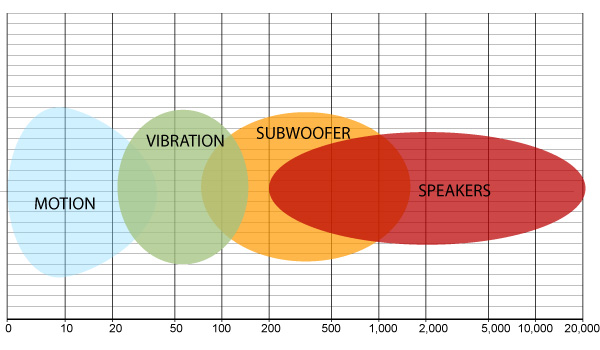
NON-LOCALIZED EFFECTS
None localized means that the apparent source of the effect is not obvious and feels or sounds natural. In other words, you hear the sound either all around you or from the location where it should come from in a real car. Likewise, vibration is distributed to your feet, hands and torso in the same way you would feel that vibration sitting in a real race car.
While it is relatively easy to balance the levels of all of the effects, it is much harder to make them non-localized. For example, putting a single vibration transducer under the racing seat feels like your butt is vibrating (exactly what is happening!). But by adding a second vibration transducer in the lumbar area behind the seat, now the entire seat vibrates which feels like you are sitting in the car.
Likewise, positioning the loudspeakers and creating a proper multi-dimensional illusion is important since the driver is very close to the speakers. It is difficult to design a near-field sound system so the listener hears an integrated image of the sound rather than sound coming from four or five separate locations.
VirtualGT uses special signal processing in order to take these closely spaced speakers and spread them apart, making the sound feel like it’s all around your head and that you are right inside the car with all the energy.
SPECIAL VIBRATION SYSTEM
Our vibration system is highly detailed, more so than any other simulator ever produced.
Rather than depend on the D-BOX motion actuators to transmit its vibration to the drivers feet hands and torso, we place vibration transducers directly onto the pedals, on the steering wheel’s mounting bracket and two transducers on the racing seat.
Furthermore, the signal to these transducers is supplied by (4) 60W amplifier channels with special signal processing that significantly enhances the vibration level and content. Revving a big-block V-8 engine will literally blur your vision!
As a result, you feel like you are sitting in a high performance race car.
ADDING MOTION
Adding subtle but very accurate D-BOX motion cueing to the spectacular audio and non-localized vibration finishes off the “grand illusion”.
The secret is to not overdo the motion so we continue to use the 1.5 inch stroke actuators while other simulator companies offer the 3 inch and 6 inch actuators (the “more is better” club).
This kind of motion, by definition, cannot move this seat vertically.
Look at the YouTube video here. You can see there is almost no vertical motion produced by this system.
In fact, if you watch the nose of the various race cars in this video, you will see vertical motion on the nose but NO cooresponding vertical movement of the driver’s head.
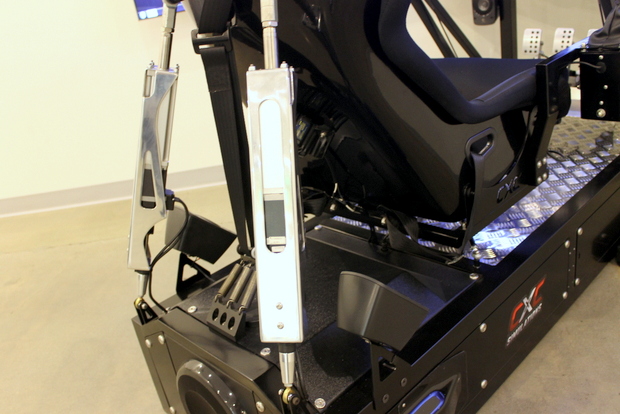
VirtualGT motion moves the entire cockpit. Moving only the seat is extremely unnatural as the driver’s hands and feet are being pushed and pulled away from the controls. Furthermore, the very concept of two cylinders moving a seat that is supported by a pivot underneath, means this seat cannot move vertically.
VGT offers full vertical motion. Vertical motion (Z-axis) is the most important motion in a racing simulator. This motion axis is critical to expressing the weight transfer when cornering. Vertical motion also enables you feel the undulations in the track surface and effects of running over the aprons.
Motion systems that only move the seat claim “low mass” as an advantage. Actually, these motion systems tend to be abrupt and jerky. They do not properly represent the inertia of a 2,000 to 3,000 pound vehicle. In the video above, notice how franticly the seat is moving the driver.
VGT’S ADVANCED MOTION SYSTEM
This motion mystem fits precisely under every VGT cockpit we’ve ever made and moves the entire cockpit.
The tubular steel frame system supports the VGT cockpit to relieve any stress on the cockpit from the four motion actuators. Other simulators that use D-BOX motion actuators bolt them directly onto their cockpit structure.
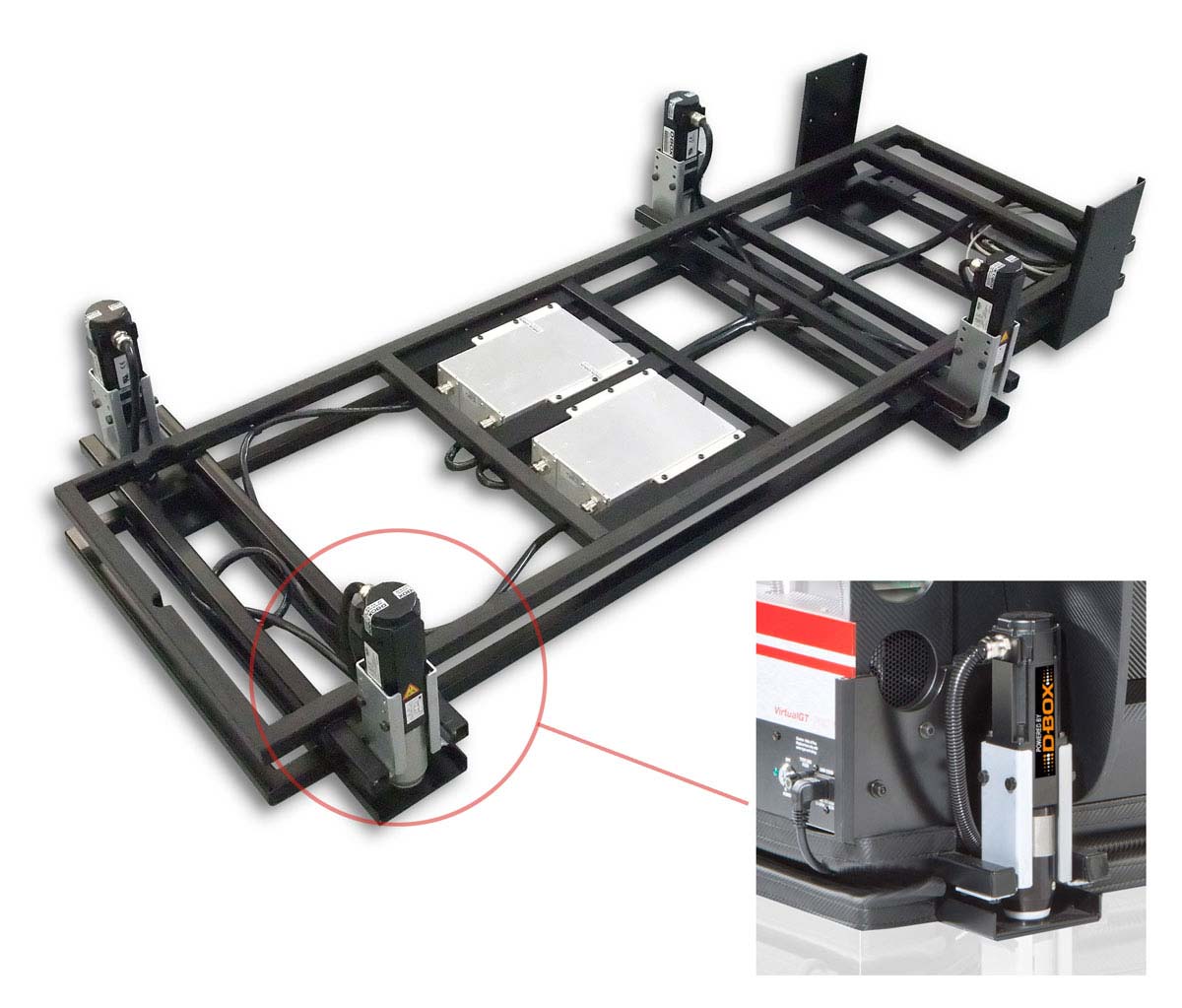
MOTION ROLL CENTERS
This moving seat found in many simulators also results in a higher roll center.
When the pivot for the motion is above the driver’s feet, the motion feels unnatural. Your body swings one way while your legs and feet swing the other way.
This never happens in a real car where the roll center is just inches off the ground. This difference is illustrated below.
Some other simulators
HIGH ROLL CENTER
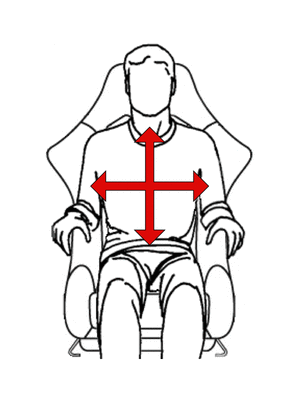
VirtualGT’s
LOW ROLL CENTER
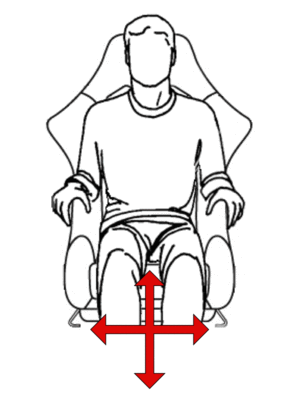
CUSTOM ELECTRONICS
VirtualGT delivers the very best Full Body Experience available today, at any price, because we have incorporated custom electronics, designed and built by us, into every VGT cockpit.
AUDIO SYSTEM BLOCK DIAGRAM (see full-size version here)
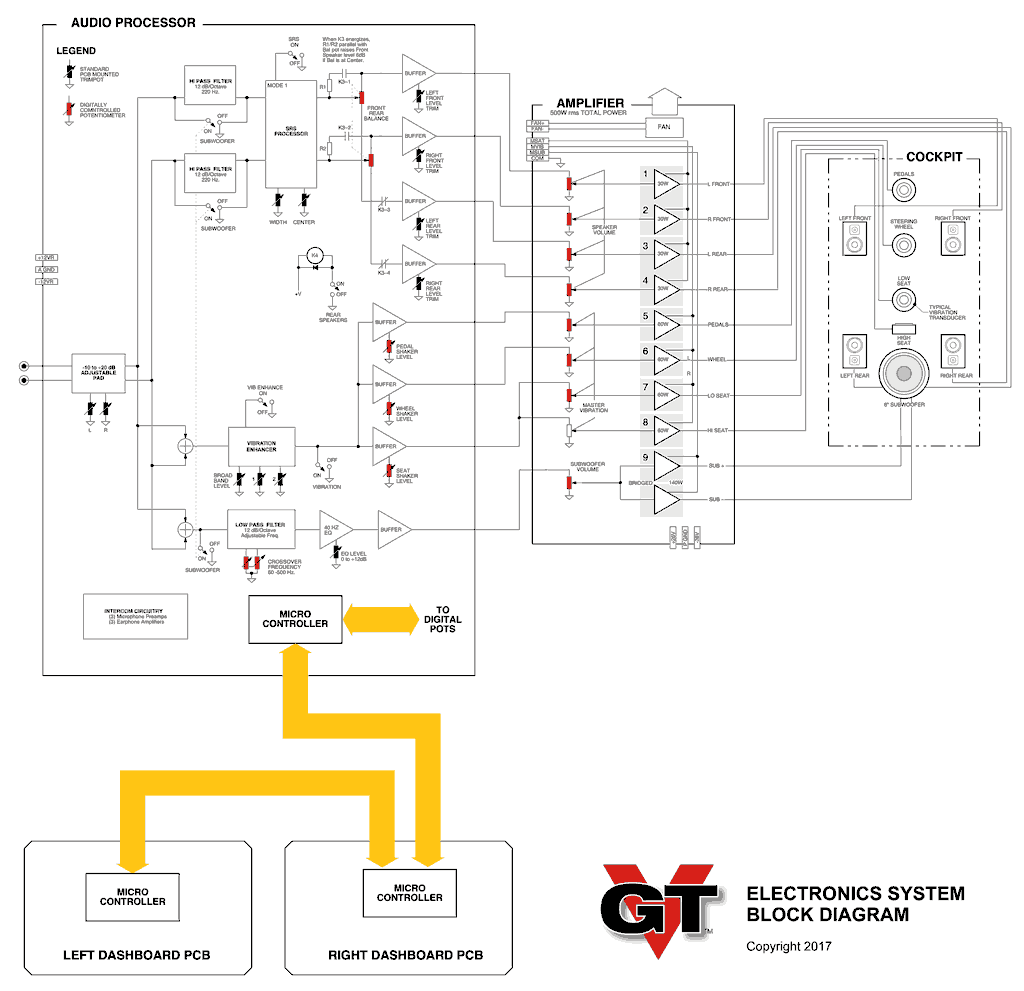
DASH
- Left Dash and Right Dash – these PC boards provide the controls to operate the simulator and set up the effects. Includes (6) Audio Setup Memories which is how we change the VGT volume.
- Dash Interface – this PC board is behind the dash and distributes power and data between the dashboards and the electronics in the back.
E-RACK (Electronics Rack)
( the electronic assembly behind the driver seat with the exhaust pipe)
- Audio Processor – this PC board takes the analog stereo output from the PC and provides the following signals and functionality:
- Input Buffer
- Electronic Crossover to divide frequencies between subwoofer and satellite speakers; has adjustable subwoofer crossover frequency and level controls
- Active Fader to balance the level between front and rear speakers
- 4-Channel volume control
- SRS Pseudo-Surround processor
- Special Vibration Enhancer circuit that radically increases the vibration effect. This is a unique property only availbel from VirtualGT.
- 3 headphone amplifiers driving a 600 ohm, full-duplex intercom system that connects multiple VirtualGT’s together. 3 headphone jacks are provided on each unit.
- Separate headset mic and earphone level controls for the intercom above
- Digital level controls allowing remote control of all functions above from the dash panel using the built-in RS-232 serial bus
- Audio Amplifier
- (4) satellite speakers
- (4) vibration transducers
- (1) subwoofer speaker
- Custom 500 Watt rms audio amplifier with 9-channels
- Electronic shutdown option used for muting each system separately or all systems together
- Crossover
- (4) independent multi-element passive crossover networks designed specifically for the satellite speakers used in the VGT.
- Power Supply
- +/- 12 Vdc for the Audio Processor (1 module)
- +/-26 Vdc for the Audio Amplifier (2 modules)
- +24 Vdc for dashboard fans and accessories
- (1) Cosel industrial quality 4-module, 650 W digital switching power supply provides the following voltages:
- (1) Cosel industrial quality 12 V, 10 W digital switching power supply for 12 Vdc accessory power. This auxiliary power supply comes on with the rear key-switch and powers the microprocessors in standby mode.
13 – TRANSDUCERS
- (4) 3″ aluminum cone Mid-Woofers
- (4) 3/8″ polycarbonate dome tweeters
- (4) ADX Maximus bass shakers
- (1) 8″ Carbon-Fiber subwoofer
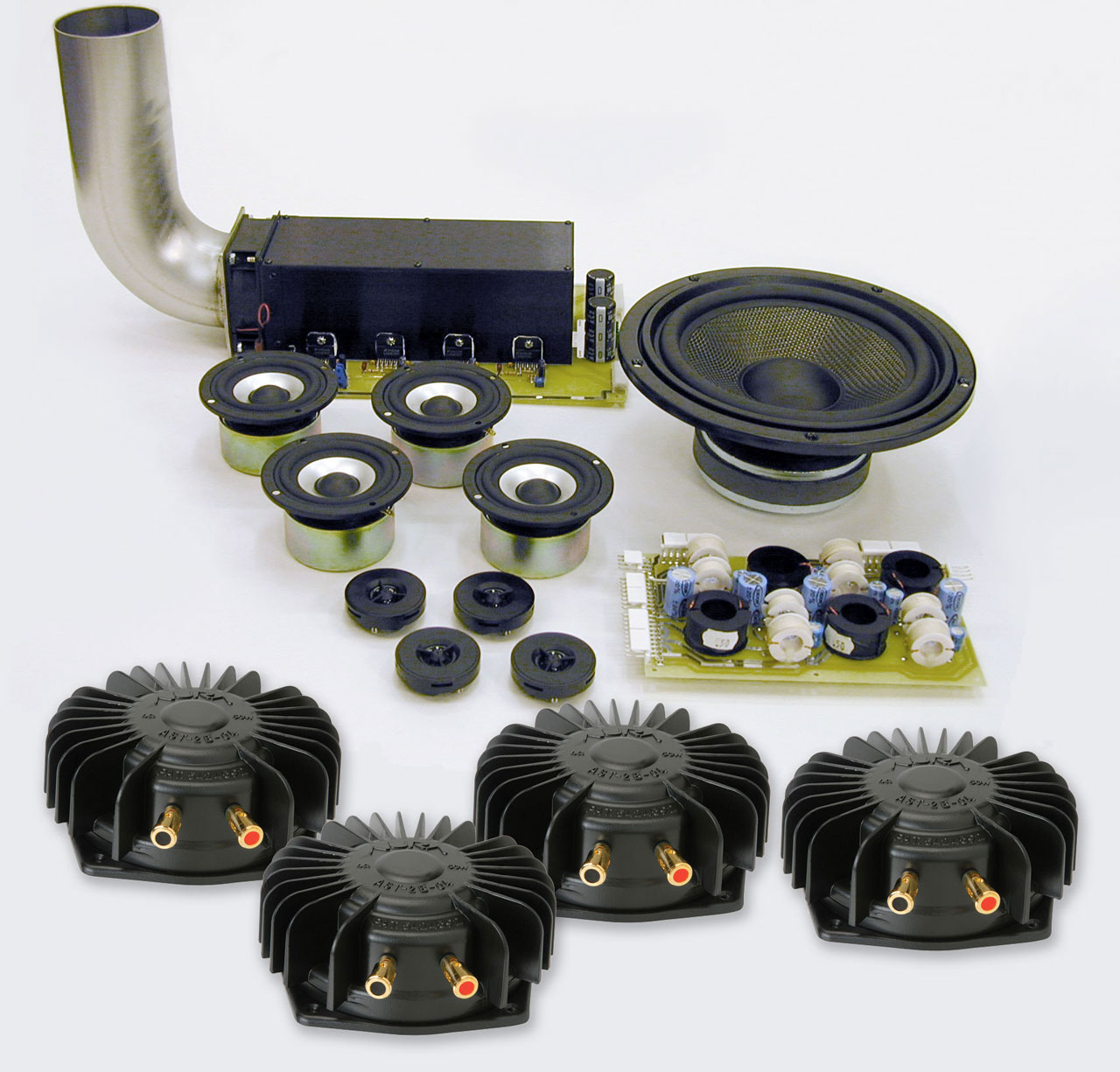
With 550 units in the field since 2003, we’ve had less than 6 total loudspeaker driver failures!
WIRING
- (79) cable assemblies connect all the controls, electronics and transducers together. This wiring is cleverly hidden within the cockpit design so there are no loose wires.
- This wiring represents nearly 1/8 of a mile of individual conductors if laid end-to-end.
Here is the wiring diagram for the Generation 2 E-Rack with digital switch-mode power supply
E-RACK WIRING DIAGRAM (view full-size PDF)
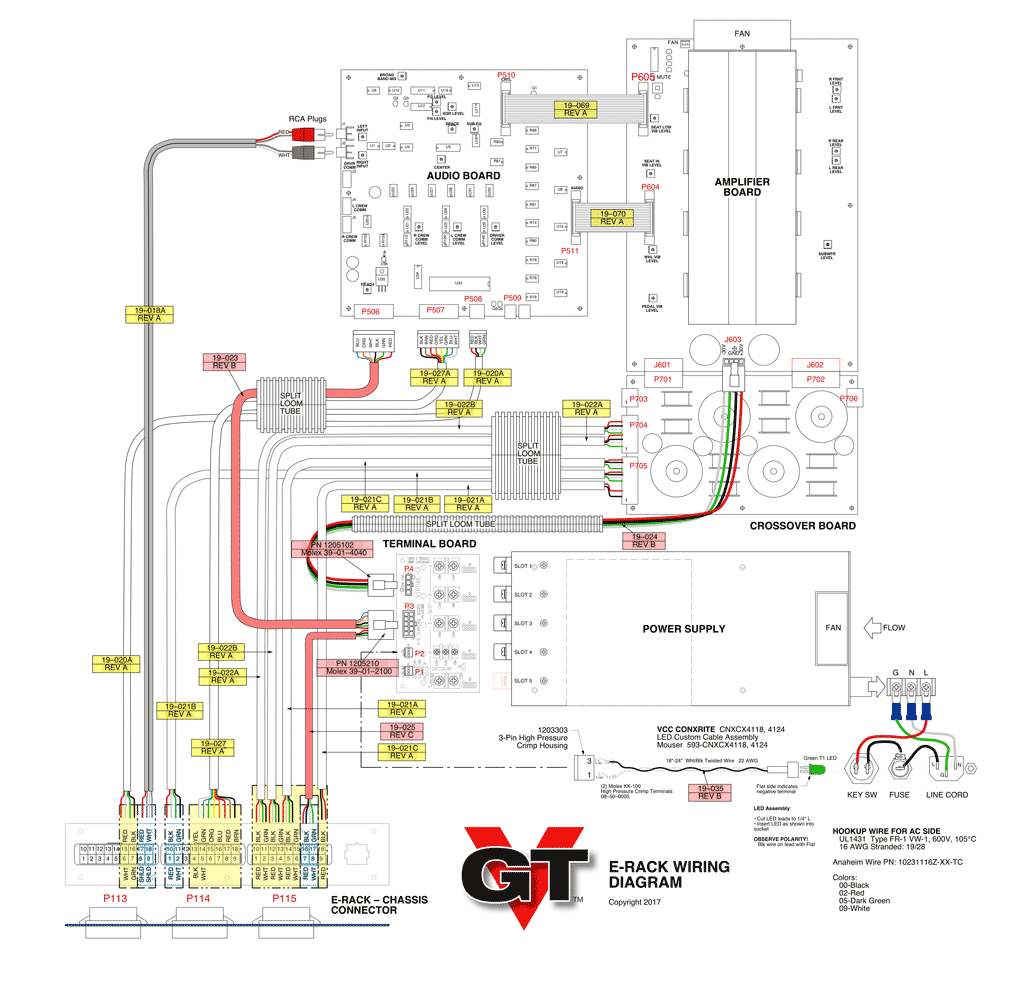
They do not include any custom electronics.
None create a solid audio illusion that makes you believe you are inside the cockpit. No other simulator uses multiple vibration transducers to provide an intense, non-localized vibration effect.
Furthermore, because we incorporate our own vibration system, we significantly reduce the vibration component of the D-BOX motion actuators.
This nearly doubles the motion actuator life as this high-frequency vibration contributes to most of the actuator bearing wear, the primary cause of failure.
VGT COCKPIT – MADE FROM WOOD
These panels are CNC routed, edged radiused, CNC end-bored, hand sanded and then primed with a high-body automotive primer.
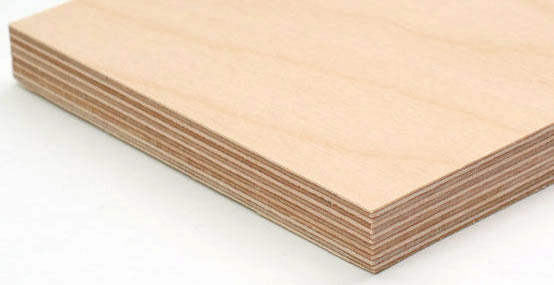
These panels create a very strong and lightweight “amorphous” vehicle structure that includes a full dash, steering column, carpeted floor and is structurally similar to sitting in an actual race car cockpit.
The Baltic Birch panels are connected together using flange nuts, dowel nuts and alloy cap screws.
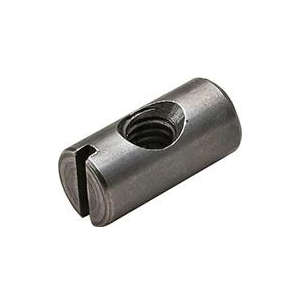
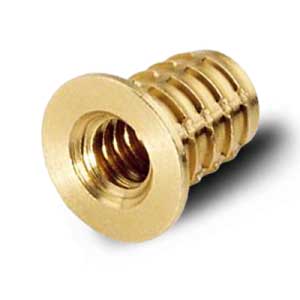
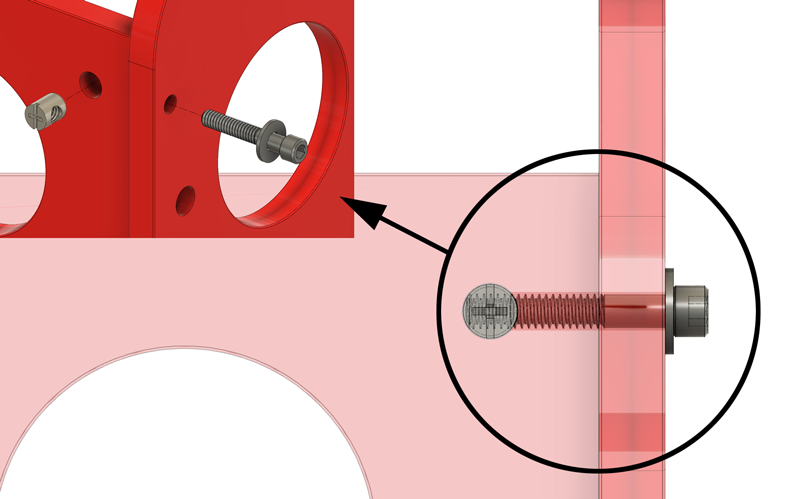
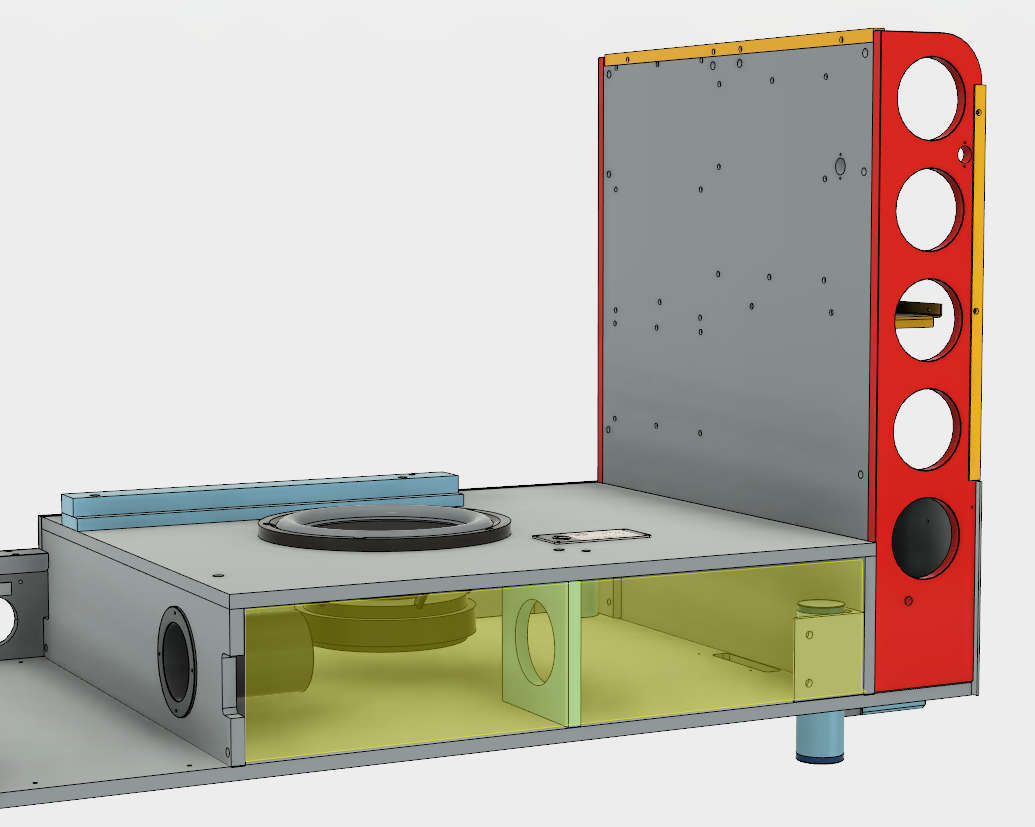
While normally you would limit the frequencies going into the vibration transducers to just those low frequencies that you can feel, we also add in a high-frequency component that provides an omnidirectional sound field, transmitted through the wood panels, to supplement the (4) satellite speakers (2 front and 2 rear).
The net effect is a uniquely “in your face” sound that is spread out all around you, but very close. You are in the cockpit!
VGT CHASSIS – RANGE OF ADJUSTMENT
The cockpit design also offers a wide range of adjustability.
- The pedal base slides 9″ fore and aft.
- The racing seat also slides 9″ fore and aft.
- The dash struts offer (4) mounting holes at the bottom, enabling the entire Dash assembly to pivot forward (away from the driver) and raising the dash, and backwards (towards the driver) while lowering the dash.
This allows the unit to accommodate a wide range of driver sizes from 4 ft. to 7 ft tall. We can verify a 7 footer will fit as the first two units sold went to a client who is 7′ 1″ tall and weighs 350 lbs.
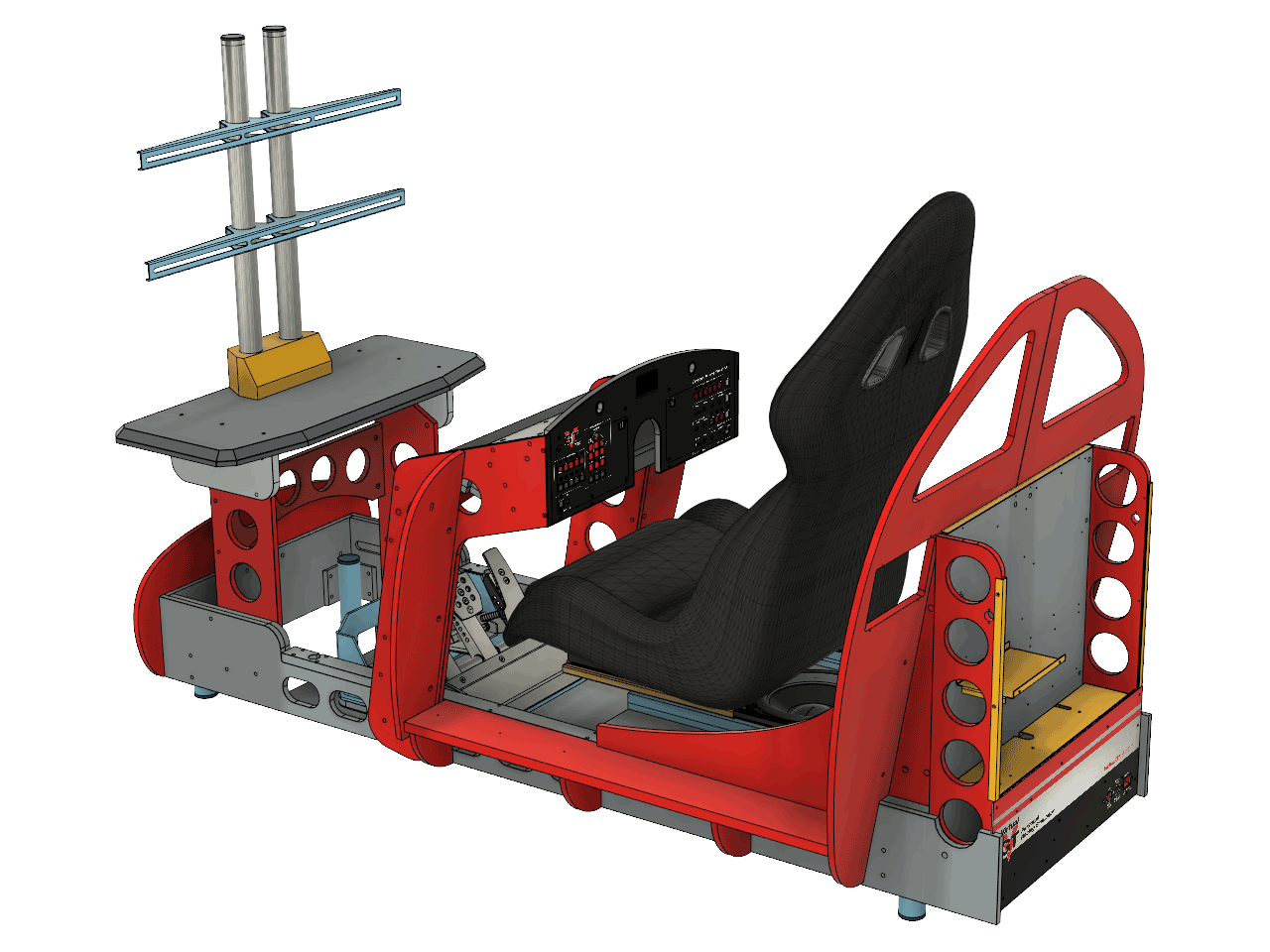
Side displays, for triple-screen display systems, can be mounted to the walls when the VGT is located in a corner or onto one of our several freestanding display enclosures.
The key is the “enclosure” which is the hallmark of all VirtualGT simulators.
DISPLAY SYSTEMS
No other simulator manufacturer provides a full display enclosure around their displays. Not only does VirtualGT provide such an enclosure, we utilize the enclosure as a significant design element.
Our Race Corner enclosure concept integrates the VirtualGT into a room like no other simulator.
The resulting simulation system looks built-in and can be styled to match room decor. It can also include your favorite race team logos and colors, car brands and personal motorsports identity.
This fully enclosed triple screen display places you within the experience. Again, relating back to a movie theater, the video display is terminated by flat black panels that are also acoustically absorptive. This shields the displays from ambient light as well as tunnels your vision onto the road ahead. It also improves the audio system.
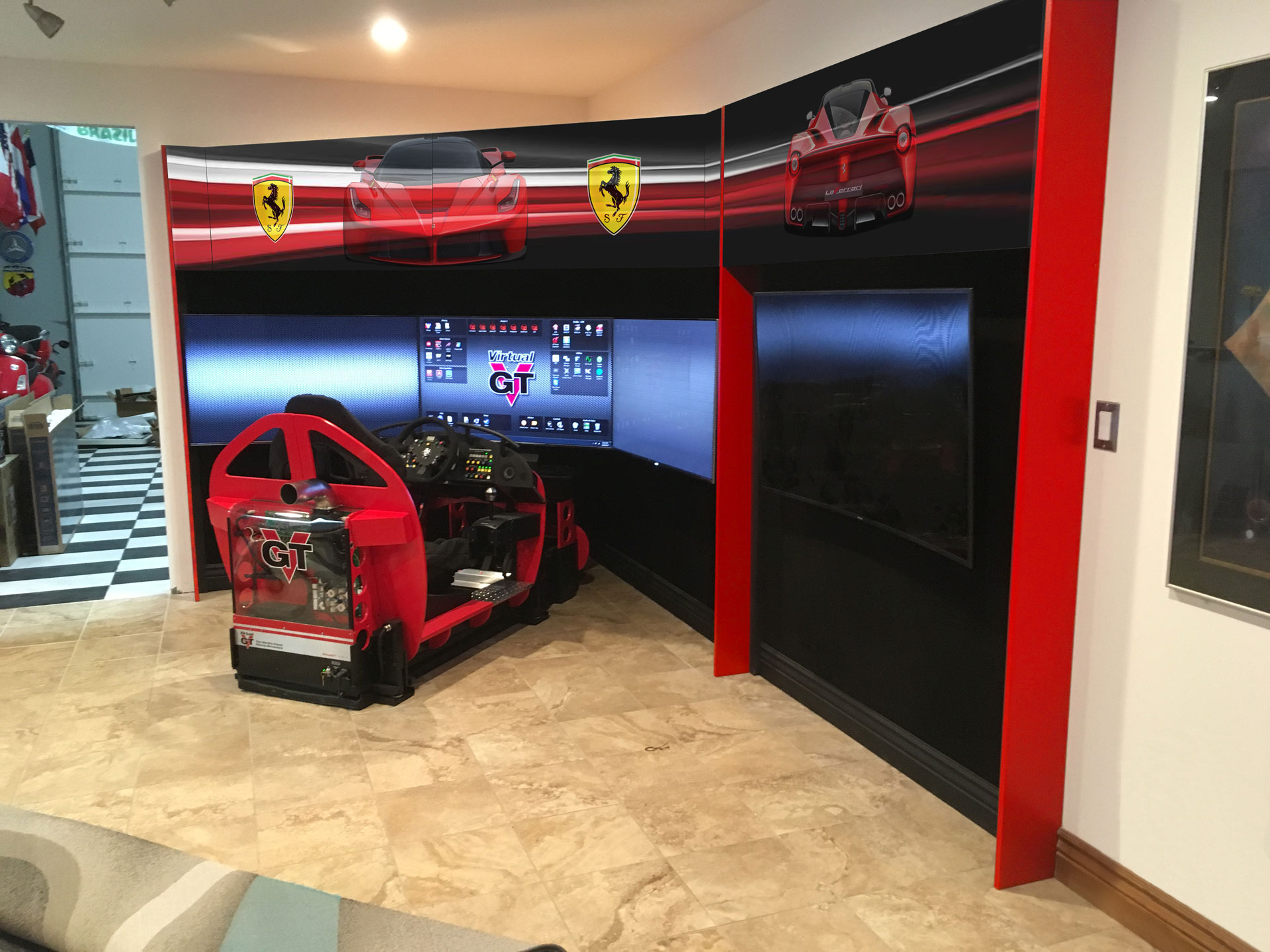
- A design review-consultation to help you choose the best location.
- Provide a scaled floor plan to show the system in context.
- Provide a 3-D model to visualize the final appearance and confirm finishes.
- Provide a complete set of CAD drawings to enable you to build or contract the fabrication of the enclosure.
- Provide a Home Depot materials list with every item required to build the enclosure.
- Provide telephone and email support for the fabrication process.
- Provide the recommended display models that you can purchase locally.
Thus, you obtain this unique display enclosure at a significantly lower cost than otherwise possible.
However, if you would rather have us provide the display enclosure, we will build and ship the enclosure with your VGT. Our installation technician will assemble the enclosure and install the displays and VGT on-site. We charge $5,995 plus installation for this enclosure option. You still purchase the displays locally.
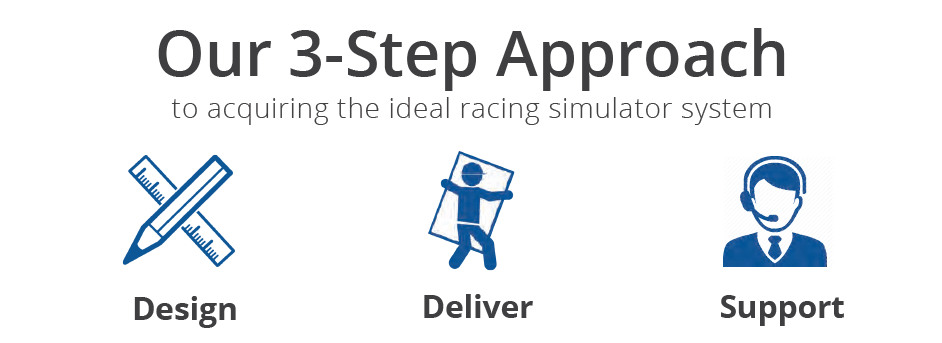
In order to make this process easy to understand, we have broken it down into 3 steps:
Design, Deliver and Support.
In analyzing the sales process over 19 years of business experience, these are the three most critical areas that concern every simulator buyer.
- You need help to define and configure the product that best fits your needs.
- You need to understand how much the simulator costs, why it cost that much and how it gets delivered and installed.
- Finally you must know how to operate the simulator and when you need help, someone must be available to provide that help.
Here is a flowchart of our three-step process.

SUMMARY
VirtualGT offers a superior product that is ideally suited for high-end applications. Our sales process insures your VGT is equipped to deliver the performance you want and need. Our support is comprehensive and ongoing.
Obviously at our $20,000-$50,000 price point, not everyone can or will buy a VirtualGT. But if you look closely at other competitors in this price range, VirtualGT actually delivers the highest performance and best value.
Given the high quality experience delivered by VirtualGT, its 19-year track record with over 550 units delivered, and demonstrated reliability, it is the perfect product for a commercial race center. For such a center to be successful, the hardware and software must deliver an ultra high-fidelity experience that looks incredible, provides an authentic and exciting racing experience and is reliable. VirtualGT has demonstrated its performance in all three of these critical areas.
Are you ready for the best simulated racing experience available today! Reach out to me and let us help you reach that goal.
Thank you.
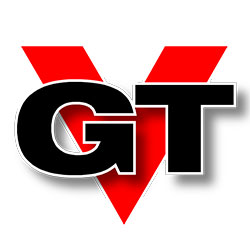
VirtualGT by Audio-Video Engineering
Direct: (949) 646-8877
Email: info@virtual-gt.com

